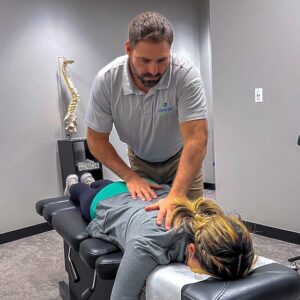Are you experiencing sore muscles but, because of all the conflicting information online, you’re not sure if you should use ice or heat therapy?
You’ve come to the right place.
Muscle strain and soft tissue irritation are common issues for active individuals, office workers, and weekend warriors alike. This guide is tailored specifically to mild to moderate injuries like pulled muscles, sprains, and chronic overuse—not severe injuries or conditions requiring emergency care.
There’s often confusion about when to use heat or ice because both treatments relieve pain but work in very different ways. The timing, type of injury, and stage of healing all influence which option is better. Our approach aligns with updated health recommendations, offering practical, easy-to-follow advice backed by physiological science and clinical experience.
In this article, we’ll provide you with a simple rule of thumb and expert tips to effectively alleviate muscle pain. Whether you’re recovering from an intense workout or dealing with a nagging injury, our guidance will help you make an informed decision and reduce pain in your muscles.
And remember—chiropractic care can be an excellent complement to these therapies, helping the body recover faster by addressing musculoskeletal imbalances and improving circulation.
Let’s dive in!
Ice or Heat: Easy Rule of Thumb
The first thing you need to acknowledge is whether you have an acute injury or chronic pain. An acute injury comes promptly and doesn’t last long. On the other hand, chronic pain develops slowly over time and is usually constant and repeated.
If you have a traumatic injury like a sprain, strain, or cramp that is no older than two days, ice therapy will be the right choice. Ice will reduce the blood flow going into an affected area, which then reduces the swelling and the inflammatory fluids that are collecting in a certain area.
This happens because ice causes vasoconstriction, meaning your blood vessels narrow. This limits internal bleeding and swelling while slowing nerve activity, which helps with pain relief.
On the contrary, heat therapy is effective for muscle spasms, tight tension muscles, chronic pain from too much sitting, and other injuries that are older than a few days. Heat will open the blood vessels (vasodilation), which boosts circulation, brings in oxygen-rich blood, and accelerates tissue repair—especially helpful in the later stages of healing.
Science Behind Heat & Ice Therapy
When you apply ice, it triggers vasoconstriction. This narrows the blood vessels, helping reduce swelling and fluid buildup in the affected area. It also slows nerve conduction, which can quickly ease pain and reduce muscle spasms—ideal for fresh sports injuries or post-exercise recovery. This is why cold therapy remains a foundational tool in sports medicine, where managing acute injuries and speeding up recovery are top priorities.
In contrast, heat creates vasodilation, widening blood vessels and increasing the flow of oxygenated blood. This process delivers nutrients that support tissue regeneration and flushes away waste byproducts, which can accumulate with chronic strain or stiffness.
Both therapies impact the nervous system too. Ice dulls nerve activity, reducing immediate discomfort. Heat soothes by relaxing tight muscles and calming stress responses.
Understanding these physiological effects is key to using each tool at the right time in your healing journey. It’s all about matching your treatment to your body’s current phase of inflammation and repair.
How to use ice therapy.
Now that you have applied our rule of thumb to your specific injury and know that you should use cold therapy, here is how to do it properly.

The best way is to put ice or a cold gel ice pack on the skin, ideally with a thin towel or cloth barrier to avoid direct prolonged exposure. This protects the skin while still allowing therapeutic cold to penetrate. Never apply ice directly to bare skin for extended periods—this can cause frostbite or irritation.
In case you don’t have ice packs or cold gel packs on hand, feel free to use a bag of frozen vegetables—it will do the trick.
This therapy will only work if you use ice for the right amount of time. The time you hold ice on your skin must be between 10 and 20 minutes.
In this time interval, you will go through four different stages:
- Cold — an uncomfortable feeling, but it lasts only a few seconds before the tissue doesn’t adapt.
- Burning — when we apply ice, the sudden and extreme cold can trigger a strong response from the receptors, which leads to a sensation of burning or stinging.
- Aching — the next stage is the feeling of aching due to activation of thermoreceptors, overactive nerves, and cold-induced vasodilation.
- Numbness — as soon as the tissue gets numb, you take the ice off and the treatment is over.
You can repeat the cold therapy every hour, as needed. Ice therapy is safe as long as you don’t use “super cold” or dry ice because that can burn the skin.
Pro tip for athletes: Icing sore or overworked muscles right after an intense workout can help limit muscle soreness and keep recovery on track—especially after high-intensity training sessions or games.
Ice is a vasoconstrictor, meaning it causes the blood vessels to narrow and reduces internal bleeding. As a result, an ice pack immediately helps to reduce pain and swelling when applied to an acute injury.
How to Use Heat Therapy
Typically, heat therapy helps reduce the pain associated with stiff and sore muscles and joints. Before you begin exercising, apply heat packs to the affected muscles to ease your pain and prevent future pain episodes from developing. This helps with the pain because heat stimulates blood flow and increases the elasticity of the connective tissues. On top of that, heat will relax tight muscles, relieve some arthritis pain from stiff joints, and lessen muscle spasms.
Heat is generally more appropriate than ice for treating chronic pain, tightness, and muscle stiffness that has persisted for more than a couple of days. Avoid using heat on fresh injuries or when visible swelling is still present as doing so could aggravate inflammation.
The best way to apply heat is to use some form of cover, making sure there is some moisture on the cover. For example, in our office, we use packs made out of a clay substance that kind of holds heat better than most devices. In a home environment, you can use a damp towel with a hot pack on top.
Moist heat tends to be more effective than dry heat, especially for deep muscle relaxation, because moisture helps conduct heat more efficiently into the tissues. Moist heat (like steamed towels or gel packs) is ideal for penetrating sore or thick muscles, while dry heat (like electric heating pads) is more convenient and can be useful for milder or surface-level aches.
When it comes to the duration of heat treatment, it is about the same as with ice—anywhere from 10 to 20 minutes. In contrast to ice, heat therapy doesn’t have stages, so as long as you can tolerate it, it’s fine. Heat can be done very similarly to ice, every hour.
Can You Use Both Ice and Heat? (Contrast Therapy)
If you apply ice to your body and after that your muscles feel really tight and worse than before, your next step should be contrast therapy—a treatment with heat. After 10 minutes of ice, you should put the heat on for 10 minutes, then ice for 10 minutes, and heat again. You can repeat this process for up to 40 minutes.
What is Contrast Therapy?
Contrast therapy refers to alternating between cold and heat applications to stimulate circulation, reduce inflammation, and relax muscles. It’s commonly used in injury rehabilitation and athletic recovery when symptoms include both swelling and stiffness.
If you apply ice to your body and after that your muscles feel really tight and worse than before, your next step should be a treatment with heat. After 10 minutes of ice, you should put the heat on for 10 minutes, then ice for 10 minutes, and heat again. You can repeat this process for up to 40 minutes.
This is called contrast therapy, and it’s really effective because we’re bringing the blood flow into the tissue, getting everything to swell, and then adding the ice to decrease the blood flow and squeeze everything out.
Contrast therapy works like a pump for the area and assists in flushing out inflammatory byproducts, which help with the muscle spasm while also addressing the inflammation. This method is especially beneficial for sports injuries, joint sprains, and post-workout muscle recovery, when there’s a need to stimulate healing without increasing swelling.
When Should You See a Chiropractor?
Muscle pain doesn’t always come from strained tissue alone. If your discomfort persists or returns repeatedly, it may signal a deeper structural issue.
If you’ve been using heat or ice therapy and haven’t experienced significant relief, it might be time to see a chiropractor. A professional evaluation can reveal if spinal misalignments, joint restrictions, or postural imbalances are contributing to your ongoing symptoms.
Of course, chiropractors don’t just treat pain—they investigate and work to correct the source. Misalignments in the spine or pelvis can create uneven stress on muscles, leading to tightness, spasms, or limited range of motion.
Through gentle adjustments, soft tissue techniques, and personalized care plans, chiropractic treatment can support your body’s natural healing process. In many cases, these therapies can also complement your heat or ice regimen by correcting the underlying cause of strain or imbalance.
In some cases, chiropractic care may be paired with physical therapy to further support rehabilitation through guided exercises, mobility work, and strength training tailored to your specific needs.
If you’re dealing with persistent soreness, schedule an evaluation with our team at Evolve Chiropractic—we’re here to help you feel better, move better, and get back to what you love.
Frequently Asked Questions
Working with patients every day, we get these questions all the time, so we’ve prepared answers for them to clear up any doubts you might have.

Should I use heat or cold for muscle pain?
For healing chronic muscle pain and soreness, like lower back pain, it’s better to use heat. High temperatures soothe muscle pain, relieve tight muscles, and improve range of motion. You can apply a heating pad and warm compresses to target a specific area, or you can try whole-body treatments like saunas and hot baths.
Should I choose ice or heat for muscle spasm?
A muscle spasm, also known as a muscle cramp, is an involuntary and sudden contraction of a muscle or group of muscles. It can cause pain and a temporary loss of control over the affected muscle. The treatment for a muscle spasm depends on the underlying cause and the stage of the spasm, but the usual initial approach is heat therapy rather than ice.
What will help me relieve the pain—ice or heat for pulled muscle in back?
For the pulled muscle in your back, it’s better to use ice, especially if the injury is still brand new. The same is true of knee pain. Make sure to follow our guidelines above to get the best results.
I’ve tried everything, and nothing helps. What should I do?
If you tried both types of therapies and the pain is still there—you must see a doctor. Only a professional can properly identify and treat the source of the pain and help with pain management.
Our mission is to help everyone live a painless and active life. If you need help and guidelines from a professional, contact us, and we will be more than happy to release the pain.
How often should I use ice or heat therapy?
Both can be used safely several times a day. Apply either therapy for 10–20 minutes, take a break, and repeat up to every hour as needed. Be cautious not to overdo it—if the area becomes red, overly sensitive, or uncomfortable, give it more time to rest.
Can I use ice or heat after a chiropractic adjustment?
Yes! In fact, applying ice after an adjustment can reduce temporary inflammation or soreness. If your issue is related to chronic tension, heat may be recommended instead. Your chiropractor will guide you based on your treatment plan.
Key Takeaways
Understanding the type of pain and when and how to use ice or heat therapy can make a significant difference in shortening the recovery period and helping with chronic conditions and acute injuries, pains, and stiffness.
- For acute injuries, applying ice directly to the skin can effectively reduce pain and swelling. It is recommended to use an ice pack for approximately 10 to 20 minutes and repeat the process every hour.
- Use heat therapy for chronic injuries to relieve persistent pain. Similar to ice therapy, heat therapy should also be applied for 10 to 20 minutes and can be repeated hourly.
- If you find that ice therapy makes your pain worse, consider contrast therapy, alternating between ice and heat, as it may yield better results.
- If your pain becomes unbearable or persists, it is crucial to seek professional advice and guidance to ensure proper treatment and recovery.
Still unsure which method is best for your pain? Book an appointment with Evolve Chiropractic today and let us guide you toward the right solution.
Remember, the well-being of your body should always be a priority, and consulting with a healthcare professional is essential for optimal care.
{Note: This content is for educational purposes only and should not be taken as medical advice. If you or any other person has a medical concern, you should consult with your healthcare provider or seek other professional medical treatment. Never disregard professional medical advice or delay in seeking it because of something that have read on this blog or in any linked materials.}





